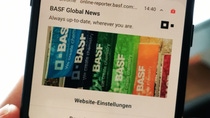Media
Plasticizers for the PVC industry are now also available based on renewable and chemically recycled feedstock
- Saving of fossil resources and reduction of CO2 emissions
- Contribution to recycling of plastic waste and to increased use of renewable raw materials
- Same specifications and technical properties as those of conventional plasticizers enable customers to easily transition or produce “special editions”
BASF now offers part of its plasticizer portfolio based on circular feedstocks. For this purpose, either renewable or chemically recycled feedstock is used at the beginning of the value chain instead of fossil resources. The alternative feedstock is allocated to the sales products according to a mass balance approach.
Biomass balanced plasticizers based on renewable feedstock
BASF has launched biomass balanced (BMB) plasticizers based on renewable raw materials under the names Hexamoll® DINCH BMB, Palatinol® N BMB, Palatinol® 10-P BMB and Plastomoll® DOA BMB. Instead of fossil resources, the required amount of bio-naphtha or biogas is used. These materials are derived from organic waste or vegetable oils. Biomass balanced plasticizers have a lower carbon footprint than the conventional ones and help save fossil resources. Both, BASF’s mass balance approach and BMB plasticizers are certified according to REDcert2.
CcycledTM plasticizer based on chemically recycled feedstock
With Hexamoll® DINCH CcycledTM, BASF additionally launched its trusted non-phthalate plasticizer based on chemically recycled feedstock. In the manufacturing process, BASF uses pyrolysis oil obtained from previously non-recycled plastic waste instead of fossil resources at the beginning of the value chain. The oil is supplied by partners as part of BASF’s ChemCycling™ project. The allocation to CcycledTM sales products is also done by using a third-party certified mass balance approach. The resulting products contribute to the recycling of plastic waste.
Contributing to a Circular Economy
“The mass balance approach enables us to process renewable and recycled feedstocks together with fossil raw materials in our existing efficient production network and to allocate their share to specific products,” explains Diana Brunnenkant, Head of Marketing Plasticizers EMEA. “The principle is similar to that of green electricity. Consumers can be sure that the share of green energy in the overall electricity grid increases due to their decision to purchase it. However, the electricity they use in their homes is not only generated from renewable energy sources.”
“Our customers are increasingly facing pressure with regards to resource-efficient products,” says Dr. Matthias Pfeiffer, Head of Technical Marketing Plasticizers EMEA. “With these products we offer a more sustainable solution and make another step towards a circular economy.”
For customers it does not take additional effort to either switch the production to the new plasticizers or to produce special editions. Thanks to the same specifications and technical properties as regular plasticizers, there is no need for additional sampling or release testing of the new plasticizers. Transportation and warehousing can also be done together with the regular products.
Plasticizers are used in many different applications, including films, insulation for cables and ducts, coatings, flooring, hoses and profiles. They are also an essential part of sensitive applications such as toys, medical products, sports and leisure equipment as well as food packaging. They give flexibility to PVC products and at the same time they offer protection against the effects of weathering and temperature, thereby helping to maintain the products’ functionality.
Here, you can find more information on the new plasticizers.
Read more about the Biomass Balance Approach and the ChemCyclingTM project.
About BASF’s Petrochemicals division
The Petrochemicals division is the starting point for BASF’s petrochemical-based value chains globally. We operate a highly competitive asset base with best-in-class technologies and set the benchmark in safety, sustainability, operational excellence and cost competitiveness. With six Verbund sites and several major production sites, we are close to our customers and present in the largest chemical markets worldwide. The division supplies various value chains across the company and a broad range of customer industries with high-quality chemicals, putting our customers in the center of everything we do and contributing to the organic volume growth of BASF. Our portfolio includes cracker products, industrial gases, acrylics, superabsorbent polymers, styrenic foams, alkylene oxides, glycols, alcohols, solvents and plasticizers. In 2020, the Petrochemicals division generated sales to third parties of about €5.4 billion. Further information is available online at www.petrochemicals.basf.com.
About BASF
At BASF, we create chemistry for a sustainable future. We combine economic success with environmental protection and social responsibility. More than 110,000 employees in the BASF Group contribute to the success of our customers in nearly all sectors and almost every country in the world. Our portfolio is organized into six segments: Chemicals, Materials, Industrial Solutions, Surface Technologies, Nutrition & Care and Agricultural Solutions. BASF generated sales of €59 billion in 2020. BASF shares are traded on the stock exchange in Frankfurt (BAS) and as American Depositary Receipts (BASFY) in the U.S. Further information at www.basf.com.
P-21-187

